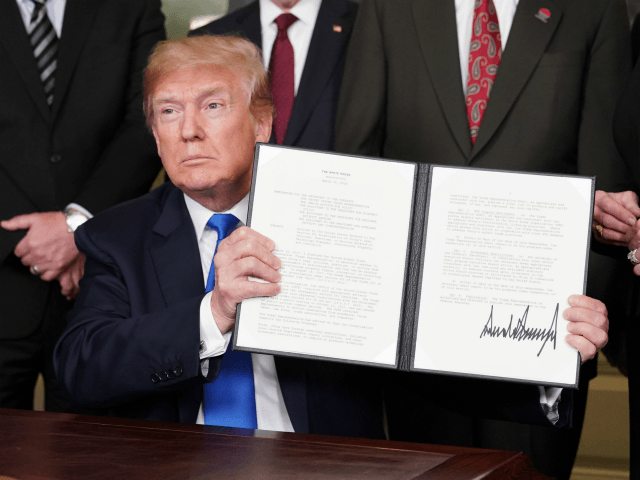President Donald Trump emphasized the importance of “reciprocal” trade as he signed a presidential memorandum on Thursday to protect the United States from China’s economic aggression and theft of intellectual property.
“We’ve lost, over a fairly short period of time, 60,000 factories in our country. Closed, shuttered, gone,” said Trump. “Six million jobs at least, gone. And now they’re starting to come back. You see what’s happening with Chrysler, with FoxConn, with so many other companies wanting to come back in to the United States.”
The President said however, that the $504 billion trade deficit with “friend” China, is a problem. He prefaced his comments with China’s help on the issue of North Korea. He acknowledged varying figures for the trade deficit, but added, “any way you look at it, it is the largest deficit of any country in the history of our world. It’s out of control.”
Trump then pointed to the “tremendous” problem of intellectual property theft, “hundreds of billions of dollars” annually. He said he’s spoken to President Xi Jinping and other representatives from China.
The President then spoke of countries entering into trade negotiations with the U.S. including NAFTA renegotiations and new negotiations with the European Union. He accused the EU of erecting harshly restrictive trade barriers against the U.S. including tariffs.
Trump said the new 301 action that “could be about 60 billion dollars,” but that that was merely a fraction of “what we’re talking about.” He has asked the highest Chinese representatives and President Xi to “reduce the trade deficit immediately by 100 billion dollars.”
“When they charge 25 percent for a car to go in and we charge two percent for their car to come in to the United States, that’s not good,” said Trump. “That’s how China rebuilt itself.”
Trump talked about the “tremendous money” that the U.S. has paid since the founding of the disastrous World Trade Organization (WTO). He called the WTO arbitration and judging “very unfair.”
From the WTO to NAFTA to China to the EU, “every single one of them wants to negotiate,” according to the President. “I believe that in many cases…we’ll end up negotiating a deal.”
“We have right now an 800 billion dollar trade deficit with the world,” said Trump. “Some people call it a mirror tariff or a mirror tax, just use the word reciprocal. If they charge us, we charge them the same thing.”
President Trump said he believes other countries can’t believe they’ve gotten away with taking advantage of the United States for so long.
U.S. Trade Representative (USTR) Robert Lighthizer then took the podium to explain the section 301 statute. It gives authority to the U.S. President to “correct actions in certain circumstances where there’s unfair acts, policies or practices by our trading partners.” Lighthizer pointed to the issue of technology in particular as the “backbone of the future of the American economy.” 44 million people in the U.S. work in the area of technology according to Lighthizer.
USTR conducted a study, held hearings and reviewed tens of thousands of documents, talked to business people, and ultimately “concluded that in fact China does have a policy of forced technology transfer, of requiring licensing at less than economic value at state capitalism wherein they go in and buy technology in the United States in non-economic ways and then finally of cyber theft,” said Lighthizer. The result of the 200-page study and President’s analysis led to the decision to impose tariffs on “appropriate products,” put “investment restrictions on China with regard to high technology,” and will follow with a WTO case for a WTO violation.
“Intellectual property rights are our future,” said Secretary of Commerce Wilbur Ross as he took the podium. He said that in June 2018 the U.S. Patent and Trademark Office is on track to issue its 10 millionth patent.
Vice President Mike Pence said that the 301 action sends a clear message that the Trump administration is committed to putting “American jobs and American workers first.”
“We are in the midst of very major and very positive negotiations. Positive for the United States and actually very positive for other countries also,” emphasized Trump who specifically noted negotiations with China.
Lockheed Martin CEO Marillyn Hewson stepped up to call the action a “very important moment for our country in that we are addressing what is a critical area for the aerospace and defense industry and that is protecting our intellectual property…that is the lifeblood of our companies.”
“This is number one, but this is the first of many,” said Trump as he signed the section 301 presidential memo.
Other attendees of the signing, according to the White House, included Chief of Staff General John Kelly, Assistant to the President for Homeland Security and Counterterrorism Tom Bossert, Assistant to the President and Senior Advisor for Policy Stephen Miller, Assistant to the President and Counsel to the President Don McGahn, Assistant to the President Peter Navarro, Acting White House Staff Secretary Derek Lyons, Deputy Assistant to the President for International Economic Affairs Everett Eissenstat, Chairman and CEO of Raytheon Tom Kennedy, former Director of National Intelligence ADM Dennis Blair, President of General Atomics David Alexander, CEO of Leidos Roger Krone, and former Director of the National Security Agency GEN Keith Alexander.
Ahead of the signing, White House officials briefed reporters on the upcoming action. senior White House adviser Everett Eisenstadt identified that “the end objective of these actions is to get China to modify its unfair trade practices.”
Follow Michelle Moons on Twitter @MichelleDiana

COMMENTS
Please let us know if you're having issues with commenting.